Exploring Effective Weight Management Strategies for Hardy Fat Cobs and Native Breeds in Summer
Managing the weight of hardy fat cobs and native breeds, especially during the summer months, is crucial for their health and well-being. These breeds are often prone to obesity and associated metabolic issues, such as insulin dysregulation and laminitis. In this comprehensive guide, discover how to implement effective weight management strategies for your hardy cob or native breed horse.
Understanding Where Fat is Stored

Before diving into weight management, it's essential to understand where fat is stored on your horse’s body. Fat deposits are commonly found in various areas:
- On the Neck: Fat is stored as a crest on top of the neck and on the sides. A fatty crest is not just aesthetically undesirable but also a welfare issue closely associated with laminitis and Equine Metabolic Syndrome (EMS).
- Along the Body: Fat deposits are found behind the withers, along the rib cage, over the back, and around the loins. An overweight horse will have a spine set in a gutter, and it will be difficult to feel the ribs.
- On the Quarters: Overweight cobs have apple-like, rounded buttocks with a gutter running down the middle, which differs from muscular quarters that lack such creases.
Assessing Body Condition
Accurately assessing your horse’s body condition is the first step in any weight management plan. Consider the following metrics:
- Neck: A healthy neck joins the shoulder with good definition, while an overweight neck merges with the shoulder with little angulation and a noticeable fatty crest.
- Body: Feelable ribs, a defined spine, and identifiable hip bones indicate a healthy body condition. Avoid a spine set in a gutter and fatty deposits behind the withers.
- Quarters: Muscular quarters should have no crease running down the middle, resembling an upside-down C shape from the rear.
Dietary Adjustments

Dietary changes are critical for managing weight in hardy cobs and native breeds.
Restrict Grazing
- Use strip grazing to limit access to lush pastures, especially during summer when grass is rich in calories and sugars.
- Avoid good grazing altogether if possible, as it can lead to rapid weight gain.
Soaked Hay
Feed hay that has been soaked to remove most of the sugar, thereby reducing caloric intake without starving the horse.
Low-Calorie Supplements
Choose low-calorie vitamin and mineral supplements to ensure your horse receives necessary nutrients without excess calories. Consider products from the Everyday Horse Vitamins & Supplements collection.
Appropriate Forage
Provide preserved forage low in Non-Structural Carbohydrates (NSCs) to help induce weight loss and improve insulin sensitivity, particularly important for native breeds. More detailed information can be found in resources from reputable equine welfare organizations (source).
Exercise and Activity

Exercise plays a vital role in weight management and overall health.
Regular Exercise
Incorporate regular exercise into your horse’s routine. Consider activities like walking and trotting, which help burn calories and improve insulin sensitivity.
Seasonal Weight Loss
Promote seasonal weight loss by adjusting diet and exercise regimens according to the season. During summer, for example, increase exercise and reduce caloric intake to facilitate weight loss.
Monitoring and Maintenance
Regular monitoring is essential to ensuring that your weight management plan is effective.
Body Condition Scoring
Regularly assess your horse’s body condition using the body condition scoring system to identify any changes early on.
Weight Checks
Monitor your horse’s weight regularly. If weight loss is needed, feed your horse 1.5% of their body weight in forage per day, adjusting as necessary.
Health Implications

Obesity in hardy cobs and native breeds is associated with serious health issues.
Laminitis and EMS
Excess weight, particularly fat stored around the neck and body, is closely linked with laminitis and Equine Metabolic Syndrome (EMS). These conditions can be debilitating and require careful management. For more information about weight management and these conditions, visit The Ride Out.
Practical Tips for Summer
During the summer, when grass is particularly lush and calorie-dense, follow these practical tips:
- Stable in the Afternoon: Stable your horse in the afternoon to late evening to reduce grazing time.
- Use Grazing Muzzles: If grazing is necessary, use grazing muzzles to limit grass intake.
- Increase Water Intake: Ensure your horse has access to plenty of fresh water to stay hydrated during hot summer months.
Conclusion
Managing the weight of hardy fat cobs and native breeds requires a multifaceted approach that includes dietary adjustments, regular exercise, and continuous monitoring. By understanding where fat is stored, assessing body condition accurately, and implementing effective weight management strategies, you can help your horse maintain a healthy weight and reduce the risk of associated metabolic issues. For additional advice, consulting with veterinary professionals is highly recommended. Learn more about specific products like Horse Riding Boot Collection and Horse Riding Gloves Collection that can support your horse's active lifestyle.

